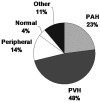Exercise-induced pulmonary arterial hypertension
- PMID: 18981305
- PMCID: PMC2767322
- DOI: 10.1161/CIRCULATIONAHA.108.787101
Exercise-induced pulmonary arterial hypertension
Abstract
Background: The clinical relevance of exercise-induced pulmonary arterial hypertension (PAH) is uncertain, and its existence has never been well studied by direct measurements of central hemodynamics. Using invasive cardiopulmonary exercise testing, we hypothesized that exercise-induced PAH represents a symptomatic stage of PAH, physiologically intermediate between resting pulmonary arterial hypertension and normal.
Methods and results: A total of 406 consecutive clinically indicated cardiopulmonary exercise tests with radial and pulmonary arterial catheters and radionuclide ventriculographic scanning were analyzed. The invasive hemodynamic phenotype of exercise-induced PAH (n=78) was compared with resting PAH (n=15) and normals (n=16). Log-log plots of mean pulmonary artery pressure versus oxygen uptake (V(.)o(2)) were obtained, and a "join-point" for a least residual sum of squares for 2 straight-line segments (slopes m1, m2) was determined; m2<m1="plateau," and m2>m1="takeoff" pattern. At maximum exercise, V(.)o(2) (55.8+/-20.3% versus 66.5+/-16.3% versus 91.7+/-13.7% predicted) was lowest in resting PAH, intermediate in exercise-induced PAH, and highest in normals, whereas mean pulmonary artery pressure (48.4+/-11.1 versus 36.6+/-5.7 versus 27.4+3.7 mm Hg) and pulmonary vascular resistance (294+/-158 versus 161+/-60 versus 62+/-20 dyne x s x cm(-5), respectively; P<0.05) followed an opposite pattern. An exercise-induced PAH plateau (n=32) was associated with lower o(2)max (60.6+/-15.1% versus 72.0+/-16.1% predicted) and maximum cardiac output (78.2+/-17.1% versus 87.8+/-18.3% predicted) and a higher resting pulmonary vascular resistance (247+/-101 versus 199+/-56 dyne x s x cm(-5); P<0.05) than takeoff (n=40). The plateau pattern was most common in resting PAH, and the takeoff pattern was present in nearly all normals.
Conclusions: Exercise-induced PAH is an early, mild, and clinically relevant phase of the PAH spectrum.
Conflict of interest statement
Figures




Comment in
-
Exercise-induced pulmonary arterial hypertension: a new addition to the spectrum of pulmonary vascular diseases.Circulation. 2008 Nov 18;118(21):2120-1. doi: 10.1161/CIRCULATIONAHA.108.819573. Circulation. 2008. PMID: 19015412 No abstract available.
-
Letter by Naeije and Melot regarding article, "Exercise-induced pulmonary arterial hypertension".Circulation. 2009 Dec 8;120(23):e283; author reply e284. doi: 10.1161/CIRCULATIONAHA.108.846287. Circulation. 2009. PMID: 19996021 No abstract available.
References
-
- Rich S, Dantzker DR, Ayres SM, Bergofsky EH, Brundage BH, Detre KM, Fishman AP, Goldring RM, Groves BM, Koerner SK, Levy PC, Reid LM, Vreim CE, Williams GW. Primary pulmonary hypertension. A national prospective study. Ann Intern Med. 1987;107:216–223. - PubMed
-
- Proudman SM, Stevens WM, Sahhar J, Celermajer D. Pulmonary arterial hypertension in systemic sclerosis: the need for early detection and treatment. Intern Med J. 2007;37:485–494. - PubMed
-
- McGoon M, Gutterman D, Steen V, Barst R, McCrory DC, Fortin TA, Loyd JE. Screening, early detection, and diagnosis of pulmonary arterial hypertension: ACCP evidence-based clinical practice guidelines. Chest. 2004;126(1suppl):14S–34S. - PubMed
-
- Grunig E, Janssen B, Mereles D, Barth U, Borst MM, Vogt IR, Fischer C, Olschewski H, Kuecherer HF, Kubler W. Abnormal pulmonary artery pressure response in asymptomatic carriers of primary pulmonary hypertension gene. Circulation. 2000;102:1145–1150. - PubMed
Publication types
MeSH terms
Grants and funding
LinkOut - more resources
Full Text Sources
Other Literature Sources
Medical

